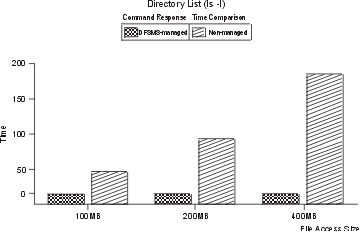 z/OS Network File System Guide and Reference
z/OS Network File System Guide and Reference
 z/OS Network File System Guide and Reference
z/OS Network File System Guide and Reference
|
Previous topic |
Next topic |
Contents |
Contact z/OS |
Library |
PDF
File size determination z/OS Network File System Guide and Reference SC23-6883-00 |
|
|
The attributes discussed previously have primarily affected data transfer rates. Whether or not to determine the exact file size in bytes has more of an effect on user command response time. This is because the file size in bytes is one of the file attributes obtained by an NFS Get Attribute procedure. The NFS Get Attribute procedure is executed for every user command accessing an NFS mounted file system. z/OS NFS provides processing attributes to specify estimated file size determination, fastfilesize, or exact file size determination, nofastfilesize. The accuracy of the file size with fastfilesize processing is best for binary processing of data sets with fixed length records. For other situations, or when exact file size is a requirement, the nofastfilesize processing attribute should be specified. When the nofastfilesize processing attribute is specified, there are performance factors to consider. The most important factor is that file size in bytes is maintained by z/OS NFS for DFSMS-managed data sets with many data set organizations. Figure 1 compares the differences in response time between the z/OS NFS attribute support for DFSMS-managed data sets and the case when attributes are not cached for non-managed data sets. In this example, all data sets were members of a PDSE data set allocated with a variable block record format. The ls -l command was executed with the z/OS NFS nofastfilesize and binary processing attributes. Figure 1. Directory list comparison
between DFSMS-managed and non-managed
 Data sets processed with the nofastfilesize attribute that are not DFSMS-managed will need to be read entirely to determine the exact file size in bytes when initially accessed by way of z/OS NFS. z/OS NFS will cache this information until the data set is modified (see section Buffer usage and caching) or the attribute time value has expired. The larger the file is, the greater the impact to command response time is. Figure 1 shows how the response time for a directory list command can be impacted when the file has to be read to determine the exact file size in bytes. Maintaining the file size attribute by z/OS NFS also affects read throughput when accessing larger DFSMS-managed data sets with the nofastfilesize processing attribute. In the nofastfilesize case, reading the entire file to determine byte file size is not necessary. The impact on the end-to-end response time for the read is lessened by reducing the response time for the initial access to obtain file attributes. 


|
 Copyright IBM Corporation 1990, 2014 Copyright IBM Corporation 1990, 2014 |